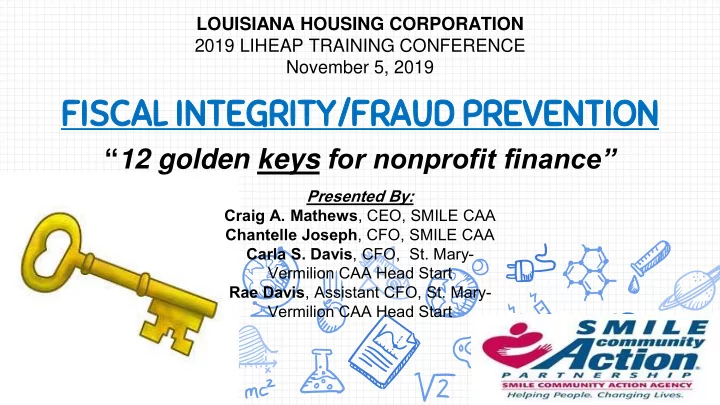

LOUISIANA HOUSING CORPORATION 2019 LIHEAP TRAINING CONFERENCE November 5, 2019 FIS ISCAL IN INTEGRITY/FRAUD PREVENTION “ 12 golden keys for nonprofit finance” Presented By: Craig A. Mathews , CEO, SMILE CAA Chantelle Joseph , CFO, SMILE CAA Carla S. Davis , CFO, St. Mary- Vermilion CAA Head Start Rae Davis , Assistant CFO, St. Mary- Vermilion CAA Head Start
COURSE TAKE- AWAYS… ✘ Nonprofit organizations impact communities and individuals by delivering services, providing advocacy, and building community. ✘ Behind the scenes, powerful missions, innovative programs, and passionate staff and volunteers are supported by sound financial activities and decisions.
COURSE TAKE- AWAYS… ✘ Healthy nonprofit organizations employ financial management practices that build stability and flexibility, both today and into the future. ✘ Federal and state agencies must ensure nonprofits employ sound operating and financial practices. ✘ In this resource we set out the “ 12 golden rules (keys) for nonprofit finance ” , including budgeting, diverse funding sources, and interdependence.
1. BUDGETING… Budgets matter because they provide the financial information to support all planning. Effective budgets are realistic, using sound assumptions and clear accountability to achieve those assumptions.
2. PROGRAM COSTS… Financial decisions rely upon accurate information. It is essential that organizations understand the real costs of their programs in order to make decisions about fundraising needs, contract terms, targeted outcomes, and program expansion or modification.
3. DIVERSE FUNDING SOURCES… While it sounds good, diversifying funding sources isn’t easy, and isn’t necessarily a smart move in the wrong situations. Different types of program revenue require different management systems, organizational structures, stakeholder relationships, and internal communications.
4. Functional/Infrastructure Expenses (aka, Core Mission Support) ✘ Nonprofits are required to account for functional expenditures – program services and general/administration & fundraising (often referred to as “ overhead ” ). ✘ While lower overhead expenses may sound better to donors, this emphasis is destabilizing and unsustainable. Make the case by reframing from “ overhead ” to “ infrastructure ” or “ Core Mission Support. ”
5. Cash Flow… Day to day, cash in the bank to pay the bills often matters more than any financial statement or long-term plan. Cash flow can be monitored and managed with a few basic management tools.
6. Financial Information… To be an effective leader, encourage everyone to develop financial literacy. This includes learning the terminology, understanding and using financial reports, and asking lots of questions. Good information and comprehensive results are provided and achieved by trained and respected staff and professionals.
7. Financial Responsibility… Responsibility for making sound financial decisions and carrying out appropriate financial activities is shared among ALL staff throughout an organization. This principle must be supported with accurate information, frequent communication, and appropriate lines of authority.
8. Operating Reserves…
9. Accountability and Transparency Between the IRS, Attorney General, foundations, and donors, everyone is demanding information and answers about how nonprofits receive and use financial resources. This trend is accelerating and many nonprofits choose to make accountability an important organizational value.
10. Financial Integrity… As public charities, nonprofits can expect to be held to a high standard of integrity and honesty in all financial activities. While policies, job descriptions, and internal controls help to maintain this integrity, they are built on the foundation of mission, values, and leadership.
11. Responding to Financial Problems… Sometimes things go wrong – contracts are terminated, grants are lost, fundraising plans flounder, and expenses skyrocket. Responding to financial problems requires strong leadership, good communication, creative planning, supportive teamwork, and decisive action.
12. Interdependence… Financial management connects to every aspect of a nonprofit – governance, planning, programs, evaluation, on and on. Keeping everything connected is what FISCAL INTEGRITY is all about.
Practical Application is key
Closing Thoughts… Using this model for collaboration with fidelity and buy-in from all stakeholders should improve overall organizational growth and maximum operational performance
Recommend
More recommend